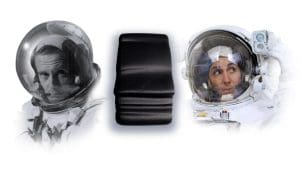Danish architecture firm Bjarke Ingels Group (BIG) has worked with Lonestar Data Holdings to create Freedom Payload, a 3D printed data centre that will be sent to the Moon later this year
Freedom uses advanced technology to create a 3D printed structure capable of withstanding the Moon’s harsh conditions, all while promoting sustainable practices in extraterrestrial environments.
It is entirely solar powered and cooled naturally, offering up to eight terabytes of storage.
Taking digital infrastructure beyond Earth
Lonestar said the Freedom Payload represents a monumental stride forward in its mission to expand cutting-edge digital infrastructure beyond Earth, protecting the data that underpins our technological society and providing a “global backup, global refresh and global restore”.
It offers the potential of a “literal living digital twin of our planet from a location, the Moon, that is so perfect for this if it wasn’t there, we’d have to built it, the company said.
Furthermore, as we transition to a digital society, the expansion of digital infrastructure to the Moon offers an environmentally friendly means to meet the planet’s data needs without carbon-heavy data centres.

A functional data hub and symbol of human potential
Freedom will house data for a series of global customers, ranging from governments, businesses and NGOs involved in veteran affairs, human rights and climate change, testing machine learning, delay tolerant networks, radiation monitoring and more.
BIG’s design is also intended to honour the legacy and future of space exploration by featuring the silhouettes of NASA astronauts and Lonestar advisory board members Charles Duke and Nicole Scott.
Crafted like a sundial, in the lunar morning, the face of Apollo 16 moonwalker Duke is cast in silhouette, symbolising the achievements of the Apollo programme.
Transitioning past midday, the silhouette shifts to retired spacewalker Stott, representing the progress and inclusivity of current and future missions under NASA’s Artemis programme.
Duke said: “It’s time to take those next steps. We built a foundation with Apollo for the future. Now let’s get out there and use it.”
Stott added: “Everything we do in space – off the Earth – is ultimately for the benefit of all life on Earth; and data is at the heart of it all. By saving our data, we save our world.”
“Freedom is not just a data centre; it’s a symbol for all humanity of what the future holds,” said Chris Stott, CEO of Lonestar. “Through this partnership with BIG, we’ve been able to embody our commitment to advancing human knowledge and protecting the data that drives our civilization.”
Freedom Payload will journey to the Moon later this year aboard an Intuitive Machines lunar lander.

